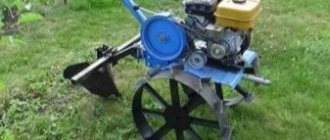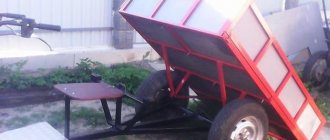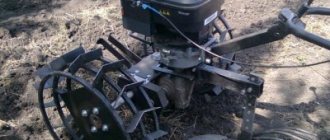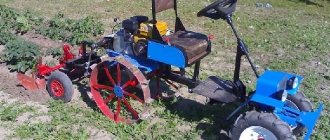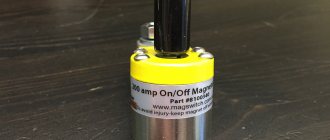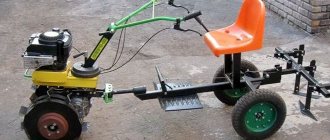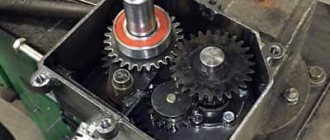Most owners of small agricultural machinery actively use all kinds of mounted and trailed equipment, increasing the versatility of their units to almost complete mechanization of most work. However, some tasks remain behind the scenes, forcing land owners to perform them manually or look for additional ways to use their walk-behind tractors. The fight against shrubs and grass that grows after harvesting is precisely one of these tasks.
A mulcher helps to cope with such unwanted growth. This device has a fairly simple design, but is extremely useful in use - it not only cuts off weeds and shrubs, but also crushes them, processing them into fertilizer, which is effectively used in growing garden crops.
Together with this attachment, weed control will not be difficult
Mulcher for walk-behind tractors - scope and types, do it yourself
Mulcher (or mulcher) is an agricultural equipment whose task is to chop and evenly distribute harvesting, mowing and pruning waste over an area.
It is known that large parts of plants and thin branches are difficult to assimilate into the soil, causing decay and impairing hydration, and when they simply dry out, the land becomes unsuitable for cultivating plants.
How to create a mulcher for a walk-behind tractor with your own hands?
To do this you need to find the following details:
- thick iron frame;
- special protective casing;
- a piece of transport plan tape;
- gearbox and 2 belt pulleys;
- shaft made of fixed knives;
- floating bearings and guide wheels (2 units each);
- fasteners to the main unit.
As you can see, in order to get the necessary device at home, you need to prepare many elements, and having experience in the construction field will only be a positive plus.
Disc and rotary working bodies of shredders
The main working tool of a mulching machine is a disk or rotor. In the first case, we are talking about a disk cutter on which carbide cutters are fixed.
This type of equipment is installed on a tractor or excavator boom. Using a disc cutter, tree trunks and stumps with a diameter of up to 50 cm are crushed (in 2–3 passes).
The power take-off of a disk cutter occurs through a hydraulic motor or gearbox driven through a cardan from the power take-off shaft. In terms of area processed per unit of time, such mulchers are inferior to rotary mulchers. When processing large areas, it is not advisable to choose a disk cutter.
Disc-type shredders are mainly used by municipal enterprises to operate in confined spaces in populated areas.
The bulk of imported equipment is equipped with a rotor, which is a rotating shaft that is fixed at the ends. The cutters on the rotor are either movable or non-movable. There are combined options.
And sometimes developers equip equipment with several types of cutting tools suitable for different vegetation.
The most important characteristics of the rotor mechanism are width and diameter. The larger the rotor, the larger the area it processes in one pass. But at the same time, the weight of the mulcher increases, which creates a need to increase the power of the energy carrier.
The process of creating a mulcher for a walk-behind tractor
- The first step is to use iron angles to obtain a frame measuring 85x65 cm;
- Then you need to get a mulcher shaft for the walk-behind tractor from a pipe (only with thick walls);
- At both ends of the resulting shaft, it is necessary to secure floating bearings used for attachment to the frame;
- Using a welding machine, you need to attach knives in a “V” shape to the shaft, which should be distributed in 4 rows;
- The knives should be placed in the following order: the largest and longest products are on rows 1 and 3 (on the edge), slightly smaller ones on rows 2 and 4, even smaller ones on rows 1 and 3, and so on in a spiral. On the other hand, you need to weld the knives using the same principle, only the longest ones need to be placed on rows 2 and 4;
- The mulcher for the walk-behind tractor should be placed on 2 guide wheels;
- Place a protective casing made from a barrel (iron) on top of the unit;
- The conveyor belt should be used to protect the operator's feet and placed at the rear of the frame.
It is worth noting that, due to its design features, such a unit will not crush thick stalks of corn, but it will cope with all the tops in the garden with all 5 points!
Design features and areas of purpose of a homemade mulcher
Unlike stationary mulchers, a homemade device for a walk-behind tractor can be transported throughout the entire site, which saves time on cleaning the area. The mulcher, installed on a walk-behind tractor, has a number of design features.
Among them are:
- a homemade device is made for walk-behind tractors with engine power ranging from 5 to 12 hp. With.;
- the shaft, together with the legs located on it, reaches a speed of 1500 rpm when rotating;
- a homemade mulcher can be attached to the front or rear of the walk-behind tractor;
- crushed parts of branches and leaves do not exceed a length of 2 cm;
- To assemble the mulcher, knives made of structural alloy steel, pre-treated at high temperatures, are used.
The areas of application of a homemade mulcher are quite extensive.
It can be actively used for the following purposes:
- for processing crop residues;
- treatment of row spacing in gardens, berry beds and vineyards;
- mowing weeds immediately before plowing virgin soil.
In some cases, a homemade mulcher is more effective than a mower. This device is capable of not only cutting off grown weeds, but also instantly crushing them, leaving them to rot in the area. Another important advantage of the equipment is its high productivity and efficiency, regardless of the thickness and height of the weeds.
What kind of animal is a mulcher?
The purpose of the mulcher is to chop and distribute straw, potato tops, tomatoes and other plants in an even layer over the soil surface. Large remains either dry out or rot for a long time, in both cases deteriorating the quality of the soil. But small remains quickly rot, and the earth absorbs most of the useful substances from them.
The mulcher, due to the high speed of rotation of the working shaft and the large number of knives on it, crushes the tops of plants, as well as the stems of growing weeds, into small pieces.
The problem is that factory mounted mulchers are designed to be mounted on tractors.
There are several models, for example, SCQ-120, which can be mounted on a mini tractor, but they also need a motor with a power of at least 25 hp for normal operation.
There are practically no walk-behind tractors with such powerful engines, so DIY craftsmen were simply forced to invent a homemade mulcher for the walk-behind tractor.
Principle of operation
The process of doing the work is quite simple and consists of two main stages:
- When moving sequentially forward, under the influence of the mulcher cutter, bushes or trees bend towards the rotor. This is where the wood is crushed into chips. Branches lying on the ground, as well as stumps, stones, etc., are grabbed directly from the ground and also enter the shredder.
- Moving in reverse, the rotor is used to capture the remaining branches and finally mix the ground mass with the soil. At the same time, special powerful cutters complete the grinding process, turning the biomass into even smaller fractions.
What a mulcher can do:
- Clear oil and gas pipelines, power transmission line exclusion zones from “extra” trees, stumps and shrubs.
- Prepare construction sites.
- Create firebreaks in forest areas.
- Destroy old gardens.
- Take care of the forest.
- Remove stumps from logging sites.
Mulchers. Models
The range of mulchers is quite wide and features an extremely wide range of equipment. There are mulchers, both universal and personal, made for various types of vehicles (tractors, excavators, loaders). But in any mulcher model, the main part is the rotor part (rotor).
In Russia, the production of medium and low speed mulchers is underway; only a few manufacturers are starting to produce high-speed mulchers. But their production is too expensive; prices for such mulchers are an order of magnitude higher than for mulchers with low and medium wood cutting speeds (used when cutting wood less than nine centimeters thick).
Choosing a tractor for a mulcher
When choosing a mulcher for a tractor or vice versa, you need to correctly approach the study of the characteristics of both the vehicle (tractor) and the equipment itself (mulcher).
In most cases, the market is filled with mulchers capable of cutting wood whose thickness does not exceed seven centimeters (shrubs, young trees), so finding a suitable mulcher remains an important task.
Pay attention to the model of the tractor, this is also the main component when working in forests.
A good mulcher will do nothing if you use a bad tractor or an outdated model of tractor, into which it may not be possible to install a modern model of mulcher.
It is always better to approach this matter tactfully, deciding in advance what exactly needs to be cut when using the mulcher. Shrubs are one thing, trees are completely different!
Hydraulic and mechanical drive
Power take-off for mulcher operation can be from a hydraulic or mechanical (PTO) drive.
In the first case, the drive is carried out from the standard hydraulic pump of a tractor, excavator or snowcat and is transmitted to the mulcher using high-pressure hoses (HPP). Such mulchers are often installed on loaders, skid steers, snow groomers and excavators.
Mounting to the energy carrier occurs using a three-point hitch, an adapter plate on tractors, or to an excavator boom using a special adapter. The main parameters of this drive are the energy carrier power of 80-450 hp.
(power range depends on the model), hydraulic flow volume from 60 to 400 l/min (flow range depends on the model) and system pressure is usually 200-300 bar.
Compared to a mechanical drive, a hydraulic drive is easier to transfer force from the tractor to the cutter, but at the same time it has lower productivity with a loss of about 20%.
We can observe a similar pattern when considering self-propelled mulching machines using the example of AHWI Prinoth Raptor line machines and similar competitive offers. The Raptor is mechanically driven using a PTO, Belts, or HDDL. Competitive machines use a hydraulic drive, where, with the appropriate power, 20-25% less equipment is used, which is directly proportional to the final productivity.
Mounted mechanically driven mulchers are compatible with power sources from 100 to 500 HP. With. And they are installed using a 3-point hitch. The force from the energy carrier is transmitted through cardan shafts, gearboxes and elastic reinforced belts.
All shredders are used for sanitary deforestation, clearing areas near power lines, highways, and gas pipelines. Suitable for reclamation of agricultural areas and destruction of abandoned gardens.
The most powerful models are equipped with double-sided cutters, which cope with chopping trees and stumps with a diameter of up to 50 cm at a speed of 4–5 km/h.
Mulchers on excavators are often used to clear hard-to-reach areas with difficult terrain.
The processing depth can be up to 10 cm and is adjusted using special slides.
Basic functions of mulching
Organic mulch is a source of nutrition for microorganisms. Under the coating layer, earthworms are more active - the soil is penetrated by their passages and is less compacted after rains and watering. The activity of microorganisms and earthworms under mulch leads to the formation of humus; organic matter is decomposed into minerals that can be absorbed by plants. Mulching also performs other important tasks:
- Maintains soil moisture even in extreme heat. In such an environment, worms with microorganisms do not stop their active life activities, and the crops have enough moisture.
- The temperature under the coating is constant with minor fluctuations. The roots are not overcooled or overheated.
- Protects the soil from leaching of nutrients and destruction of humus by sunlight. Soil covered with mulch is not at risk of erosion.
- Prevents the development of weeds. In mulched beds there are always much fewer of them, making it easier to keep clean.
- Used to decorate the area. This function can be performed either separately or in conjunction with solving agrotechnical problems.
The use of any covering material requires compliance with the following rules:
- The leaves may contain pathogens, so they are treated with antifungal drugs. Along with hay, straw, and weeds, weed seeds and pests are introduced.
- The needles are used together with ash to prevent the soil from acidifying. Nitrogen fertilizers are mixed with sawdust.
- Fresh peat can harm plants, while high peat can oxidize the soil.
- Do not use paper that is too thick or glossy - it blocks air access.
- Mulch wet soil, otherwise the layer may not allow the required amount of water to pass through. Do not place them close to the trunks and stems - they rot.
The layer of mulch is made depending on the material - the denser, the less. Flower beds and flower beds with mature plants are completely filled up, seedlings are planted in holes made in the mulch. The properties of the soil are taken into account - on dense loams the layer is not thick.
Films can also be used for mulching.
Basic functions of mulching
Organic mulch is a source of nutrition for microorganisms. Under the coating layer, earthworms are more active - the soil is penetrated by their passages and is less compacted after rains and watering. The activity of microorganisms and earthworms under mulch leads to the formation of humus; organic matter is decomposed into minerals that can be absorbed by plants. Mulching also performs other important tasks:
- Maintains soil moisture even in extreme heat. In such an environment, worms with microorganisms do not stop their active life activities, and the crops have enough moisture.
- The temperature under the coating is constant with minor fluctuations. The roots are not overcooled or overheated.
- Protects the soil from leaching of nutrients and destruction of humus by sunlight. Soil covered with mulch is not at risk of erosion.
- Prevents the development of weeds. In mulched beds there are always much fewer of them, making it easier to keep clean.
- Used to decorate the area. This function can be performed either separately or in conjunction with solving agrotechnical problems.
The use of any covering material requires compliance with the following rules:
- The leaves may contain pathogens, so they are treated with antifungal drugs. Along with hay, straw, and weeds, weed seeds and pests are introduced.
- The needles are used together with ash to prevent the soil from acidifying. Nitrogen fertilizers are mixed with sawdust.
- Fresh peat can harm plants, while high peat can oxidize the soil.
- Do not use paper that is too thick or glossy - it blocks air access.
- Mulch wet soil, otherwise the layer may not allow the required amount of water to pass through. Do not place them close to the trunks and stems - they rot.
The layer of mulch is made depending on the material - the denser, the less. Flower beds and flower beds with mature plants are completely filled up, seedlings are planted in holes made in the mulch. The properties of the soil are taken into account - on dense loams the layer is not thick.
Films can also be used for mulching.
Mulching is used in the spring on heated soil to protect it from drying out. In the fall, they are placed on uncooled ground to prevent the roots from freezing.
Mulcher for a walk-behind tractor - specifics and how to make it yourself?
Most owners of small agricultural machinery actively use all kinds of mounted and trailed equipment, increasing the versatility of their units to almost complete mechanization of most work.
However, some tasks remain behind the scenes, forcing land owners to perform them manually or look for additional ways to use their walk-behind tractors.
The fight against shrubs and grass that grows after harvesting is precisely one of these tasks.
A mulcher for a walk-behind tractor helps to cope with such unwanted growth. This device has a fairly simple design, but is extremely useful in use - it not only cuts off weeds and shrubs, but also crushes them, processing them into fertilizer, which is effectively used in growing garden crops.
Together with this attachment, weed control will not be difficult
Specifics of using a mulcher
The shredder allows you to perform a large number of preparatory and maintenance work without much effort.
The mulcher has the following characteristics:
- specially designed for walk-behind tractors with a power of 6 liters or more. With.;
- Available with front and rear attachment to the drive mechanism;
- the shaft and the movable knives located on it rotate at a speed of 1500 rpm;
- knives are used, made of alloy structural steel, heat-treated;
- the plants are chopped into pieces of about 20 mm.
The mulcher has a fairly wide range of applications:
- interrow gardens, vineyards, and berry plants are cultivated;
- crop residues are crushed;
- shoots are mowed down (effective removal of weeds before plowing virgin soil).
A mulcher is much more efficient than a mower. It simultaneously mows and shreds vegetation, which will later become fertilizer. The shredder also has a high operating speed.
How to make a mulcher for a walk-behind tractor with your own hands?
A mulcher greatly simplifies the work process in the field or garden. In order not to spend money on such equipment, you can try to make a mulcher yourself.
You need to acquire the following details:
- thick iron frame;
- special protective casing;
- a piece of transport type tape;
- a gearbox and two belt pulleys;
- shaft with locking knives;
- floating bearing and guide wheels (two units in total);
- fasteners.
As a key part, a knife, disc plates with carbide nozzles are perfect. These discs come in any reasonable size and are reliable and durable. Also, in case of destruction of the knife, it will not be difficult to purchase a disk plate.
You can use car parts. They are affordable and offered in a wide variety (alternator pulley, bearings).
Step-by-step creation of a mulcher with your own hands:
- weld the frame from the iron corners, it will be attached to the walk-behind tractor bar and can move along it to tension the drive belt. The frame is fixed with two bolts;
- determine the landing axis - the mulcher shaft, based on the diameter of the circular saws. You can use a stud with M20 thread. It is also necessary to prepare washers and nuts for the same thread. The shaft is secured with floating bearings;
- a special thrust profile is welded onto the frame at the level of the mulcher axis;
- the legs are attached to the shaft with a welding machine in the shape of a “V”;
- Under the cutting unit there is a casing that prevents the scattering of the crushed product. There is also a casing on top. The crushed particles are fed into the hopper through a closed opening;
- The conveyor belt is used to protect the operator's feet and is attached to the rear of the frame.
In terms of performance, a homemade shredder is not inferior to a purchased one. It is very efficient and will cost half the price of a store-bought one. The mulcher can be used on walk-behind tractors of various brands: Neva, MTZ, Cascade, Agro, Krot. Their power will be sufficient to use this equipment.
How to use crushed biomass as fertilizer
Shredded cardboard, kitchen waste and plant waste are used as biomass for fertilizers. This is an excellent alternative to store-bought fertilizers.
It is very important to properly prepare biomass for use in home gardens and garden plots as highly effective fertilizers.
For this purpose, special composters or standard compost heaps are used.
A mass of crushed thick shoots of perennial plants is placed at the very bottom of the compost heap. On top of this layer is covered with a small amount of already mature compost or fertile soil.
Then crushed plant waste is poured in layers.
It is necessary to sprinkle each layer with a two-centimeter layer of garden soil with dolomite or chalk at the rate of a couple of kilograms for each cubic meter of composted mass.
As a result of natural processes occurring inside the composted mass, a valuable fertilizer is formed, which can be used in almost unlimited quantities to improve the quality characteristics of the soil in the garden or to feed cultivated garden plants. Compost can be added to the soil throughout the growing season , but the optimal effect can be obtained when applied in the spring and autumn.
Around perennials and garden plantings, as well as in flower beds and flower beds, compost biomass is poured in a layer of 20-50 mm and mixed slightly with the soil. To improve the condition of lawn grass, it is enough to spread a centimeter layer.
Manufacturing Guide
The first thing you need to understand is that without plumbing and welding skills and the appropriate tools, you will not be able to make even a simple branch chopper from circular saws. In addition, for the manufacture of shafts and housings for bearings, you will have to go to a lathe, unless you manage to find a ready-made unit from an old machine. The whole process is divided into the following stages:
- Choosing a shredder design.
- Selection of motor for drive and calculation of main gear.
- Preparation of metal and parts that need to be turned on a lathe.
- Frame assembly.
- Installation of the drive, cutting mechanism and belt drive.
- Installation of the protective casing and hopper.
Note. We are talking about a belt drive as the easiest to manufacture and safest to use. In the event of an accident or overload, the belt will slip or jump off without any consequences. The same cannot be said about a rigid connection through a chain (gearbox).
As for choosing the design of a homemade wood chipper, the recommendations are simple:
- a unit made from circular saws is the best option when you need to get small wood chips at minimal cost;
- if you plan to chop branches of small diameter into a larger fraction, then a cutting mechanism such as a jointer is suitable;
- when you need to chop branches up to 5 cm in size in large quantities, it is better to make a disk crusher.
For reference. Small shavings and wood chips are often used by gardeners to make compost and mulch. You can also make fuel briquettes from it for heating a private home, which is described in detail in this article.
When the type of wood chipping is selected, you can begin procuring parts, materials and equipment. But first of all you need to do...
The lineup
If you still want to purchase a ready-made branch chopper for your walk-behind tractor, then we offer a small list of popular models on the market:
Branch chopper "Premium" (without wood splitter)
Branch chopper "Premium" (without wood splitter)
Characteristics:
- Material: steel;
- Cutting capacity: up to 50 mm;
- Product weight: 75 kg;
- Cutting mechanism type: knife system.
- The pulley for the motor tractor is included in the kit.
Branch chopper with wood splitter (TYPE - 2) Premium
Branch chopper with wood splitter (TYPE - 2) Premium
Branch chopper Volodar for walk-behind tractor RM-90D
Branch chopper Volodar for walk-behind tractor RM-90D
Chipper for walk-behind tractor RM-90 M
Chipper for walk-behind tractor RM-90 M
Types of garden shredders
There are different names for chippers used for crushing wood waste. Wood chipper, branch chopper, shredder, wood chipper - this is not a complete list of names. Despite such a variety of terms, the structure of various units is almost the same. Any crusher consists of the following elements:
- steel frame into which all parts and mechanisms are attached;
- main drive – electric motor or gasoline (diesel) engine with power take-off shaft;
- cutting mechanism;
- main drive (usually belt);
- protective casing;
- 2 bunkers - for feeding wooden sticks and unloading wood chips.
Choppers: from circular saws (left) and with a knife shaft (right)
In fact, homemade branch shredders are divided into varieties only by the design of the cutting mechanism, the remaining elements differ only in size. If you carefully review the crushing section drawings published on the Internet, you can identify the following popular solutions:
- In the middle of the shaft, 2-3 dozen circular saws equipped with carbide teeth are attached.
- A design that replicates the structure of a jointer on a circular saw. Longitudinal grooves are made on the shaft (from 2 to 6 pieces depending on the engine power), where chopping knives made of carbon steel are fixed. The branches are fed for chopping at an angle of 90° to the knives.
- A disc crusher for wood, where the knives are attached to the plane of a steel circle mounted on a shaft. Here the branches need to be fed at an angle of 30-45° to the surface of the disk, which is ensured by the design of the loading hopper.
- A chipper with two shafts that rotate synchronously. The cutting edges of the knives mounted on the shafts converge at one point when rotating. Due to this, not only crushing occurs, but also self-tightening of the branches after capture. Wood feeding is perpendicular to the rotating knives.
Crushers: disc (left) and twin-shaft (right)
Note. To increase torque and cutting force, garden shredders use a flywheel mounted on the free end of the shaft. An exception is the disc chipper for branches, where the flywheel is a heavy metal circle with attached knives.
Next we will look at how to make the first three types of garden shredders yourself. A twin-shaft wood chipper is a rather complex unit to manufacture, requiring investment and labor, which is not always justified. Do-it-yourself hammer and other original wood chippers are shown in the video:
To process thick twigs and branches into firewood, you can make a mechanized cleaver. Options and drawings of the machine are presented in our other instructions.
( 2 ratings, average 4.5 out of 5 )
Types of engines
A homemade branch chopper has one basic design. The difference may be in the power of the electric motor. For more powerful devices, a gasoline engine is used; it can be used to chop trees with trunks with a diameter of more than 100 mm. Gasoline cars are distinguished by their mobility due to their independence and independence from power sources.
Electric drives for garden wood chippers are divided into three main types based on power:
- To process waste in small areas, an engine with an operating power of up to 1.5 kW is used; it is capable of grinding branches with a diameter of up to 2 cm.
- When chopping branches up to 4 cm, a drive with a power of up to 4 kW is used on a personal plot.
- A value of 6 kW or more is used when working on wood waste collection in large areas.
Basically, when making a branch chopper with your own hands, install an electric motor of no more than 4 kW. A power value higher than this may result in high energy consumption. The speed from the drive can be 1500 rpm; to adjust this indicator, you can change the diameter of the pulley.
Torque is transmitted using a chain or belt drive, or by installing shredder blades on the engine shaft itself.
Homemade mulcher - features, scope
Many farmers often wonder what to do with grass and shrubs that grow instantly before planting and after harvest.
The answer is quite simple - a mulcher on a walk-behind tractor will help get rid of them.
This simple device crushes weeds and wild shrubs, turning them into high-quality organic fertilizer, which can later be used to grow crops.
How to make a mulcher for a walk-behind tractor with your own hands - step-by-step instructions
In order for a homemade mulcher to be as reliable, durable and shock-resistant as possible, its design must include:
- strong iron frame, reinforced with corners;
- durable protective casing;
- a piece of conveyor belt;
- gearbox and 2 belt-type pulleys;
- reliable shaft with knives attached to it;
- 2 floating bearings;
- coupling mechanism for installation on a walk-behind tractor;
- 2 guide wheels.
The assembly sequence should look like this:
- To begin with, their iron pipes and angles are welded into a frame measuring 85 x 65 cm;
- Next, you need to make a shaft for a homemade mulcher. For this purpose, you will need to use a thick-walled pipe taken from an old drill. The finished shaft should be 70 cm long and 5.8 cm thick;
- At both ends of the made shaft, you need to install one floating bearing, which is necessary for the stationary mounting of the shaft on the frame;
- When using a mulcher on a walk-behind tractor, the torque generated by the engine will be transmitted to the shaft of the device through the gearbox provided in its design, which has 2 belt-type gears. The first gear should connect the mulcher to the walk-behind tractor, and the second should connect directly to the mulcher shaft;
- Leads must be welded to the surface of the shaft, on which V-shaped knives must be installed. All knives should be arranged in 4 rows. The longest cutting parts need to be secured at the edges of the first and third rows. After 5 cm from them, on the second and fourth rows you will need to secure knives with a shorter length. Next, in the first and third rows, 5 cm from them, it is necessary to secure knives with an even shorter length. Thus, all cutting elements of the mulcher should be arranged in a spiral direction towards the middle of the shaft being used. The knives are attached to the back of the mulcher according to the same principle, with the only difference being that the longest parts need to be installed on the second and fourth rows;
- You will need to attach 2 guide wheels to the bottom of the walk-behind mulcher. With their help, you can adjust the optimal height of the structure in relation to the ground surface;
- A casing is installed on top of the frame, which can be made from half a steel barrel. A small piece of conveyor belt will need to be installed at the rear of the mulcher to protect the operator's feet.
The finished device can be taken to the site and tested. It is extremely important to make sure that the structure does not have any play during operation and does not drift in different directions during movement.
A mulcher made in this way can be actively used to work with walk-behind tractors Cascade, Agro, MTZ, Neva, Krot and other units of domestic and foreign production.
Design and principle of operation of a garden shredder
Garden shredders make gardening much easier. When describing the mechanism, in addition to the usual name, there are also synonyms - chipper or shredder. They have a fairly simple design. Main components of the mechanism:
- working shaft equipped with knives;
- motor;
- receiving box;
- metal frame with protective casing;
- Some models provide a hopper for crushed organic matter;
- a sieve that regulates the woodchip fraction;
- pusher
In addition to the main elements, there are many other small details. For easy movement, the entire structure is based on a two-wheel base. The operating principle of a garden shredder is as follows:
- The chain or belt serves as a transmission link to move the shaft due to the rotation of the motor.
- At this point, branches or other waste are fed into the receiving box.
- The knives of the working shaft crush the introduced plant material.
The resulting raw materials can be sent to compost. The operation of a garden shredder is similar to that of a meat grinder.
Mower-mulcher for walk-behind tractor
Most owners of small agricultural machinery actively use all kinds of mounted and trailed equipment, increasing the versatility of their units to almost complete mechanization of most work.
However, some tasks remain behind the scenes, forcing land owners to perform them manually or look for additional ways to use their walk-behind tractors.
The fight against shrubs and grass that grows after harvesting is precisely one of these tasks.
A mulcher for a walk-behind tractor helps to cope with such unwanted growth. This device has a fairly simple design, but is extremely useful in use - it not only cuts off weeds and shrubs, but also crushes them, processing them into fertilizer, which is effectively used in growing garden crops.
Together with this attachment, weed control will not be difficult
Features of a mulcher for a walk-behind tractor
The specificity of the mower-mulcher for a walk-behind tractor allows it to perform many tasks in preparing for plantings and caring for them, without making much effort.
The characteristics of typical mulchers include the following:
- the design is designed for an average power unit of 6 hp;
- depending on the model, it is attached to the walk-behind tractor at the front or rear;
- rotation speed of the shaft and cutting components - 1500 rpm;
- The lengths of plant chopping are about 20 mm.
Considering the capabilities of the mulcher, it can be used:
- for processing row spacing in orchards and vineyards;
- for grinding crop waste;
- to eliminate overgrowth before plowing virgin soil.
In this video we will look at a homemade mulcher mower:
Unlike a conventional mower, a mulcher not only mows down grass and shrubs, but also crushes plants at high speed, turning them into high-quality fertilizer and distributing them over the soil surface. It can also be used to chop straw, potato tops and any other plants.
It is no secret that large fragments of plants essentially turn into garbage on the site, because they either dry out or rot for a long time, which is not good for the soil.
At the same time, the crushed plants rot in record time, and the soil absorbs the maximum of valuable substances from them, becoming enriched for new plantings.
It would seem that such a useful device should be much more popular among farmers and owners of personal plots than it is today.
The reason is simple: in most cases, commercially available mulchers are designed for larger equipment than is used on small and medium-sized plots. There are several models compatible with mini tractors, but their specifications require a power plant with at least 25 hp.
, while most walk-behind tractors have a power of 5-9 hp. Therefore, in order to acquire a mulcher for your farm, you can only assemble it yourself.
How to make a mulcher with your own hands
To make a homemade mulcher for a walk-behind tractor, you first need to study its design. It consists of the following parts:
- frame;
- casing;
- conveyer belt;
- shaft with knives;
- gearbox equipped with two belt pulleys;
- two floating bearings;
- two guide wheels;
- fastening device.
A frame measuring 85x65 cm is welded from corners or metal profiles. After this, a shaft is made - the material for it may well be a piece of thick-walled pipe with a diameter of 58 mm (for example, from a drilling rig) and 700 mm in length. Bearings are fixed to the ends of the shaft and mounted on the frame.
Torque is provided by a gearbox - one belt drive connects the device to the power unit, and the other goes to the shaft.
: Mower on walk-behind tractor Ugra.
V-shaped knives are fixed to the shaft. They should be arranged in four rows. The length of the knives varies, so the order of arrangement is as follows:
- in the 1st and 3rd rows, the longest knives are installed from the edge;
- the second in length are installed on the 2nd and 4th row at a distance of 5 cm;
- even shorter knives are fixed after another 5 cm on rows 1 and 3;
- etc. in a spiral until the middle of the shaft. Further in reverse order.
The structure is equipped with two guide wheels, with which you can adjust the height relative to the ground.
After assembling all parts, the device is closed with a protective casing. The material for its manufacture can be, for example, an iron barrel. To protect the legs of the walk-behind tractor operator, a piece of conveyor belt is fixed behind the device.
A do-it-yourself mulcher for a walk-behind tractor will become an indispensable assistant in processing plants that litter the area. It is worth considering that this device cannot handle too thick plant tissues, such as corn stalks or sunflowers, but it can handle plant tops, weeds and thin shrubs quite well.
The third way to create a chopper using improvised means
In fact, this method is completely simple. At the same time, it can be made from almost any available means, such as:
· Electric motor (pump), powered by a 220 V power supply, and which can make three thousand revolutions per minute. (For example, this could be an Agidel pump).
· An old aluminum pan.
· Unnecessary hacksaws for wood carving that have already served their purpose. They can be used to make excellent and functional grass cutting knives.
· You also need to come up with a button that will start the motor. In this case, a button from an old washing machine is perfect.
· Also prepare an electrical cord and plug for connection to the electrical outlet.
You can also view photos that don’t even make sense to comment on. Everything about them is extremely clear and understandable.
How to make a mulcher for a walk-behind tractor with your own hands?
› Motoblocks
Many farmers often wonder what to do with grass and shrubs that grow instantly before planting and after harvest.
The answer is quite simple - a mulcher on a walk-behind tractor will help get rid of them.
This simple device crushes weeds and wild shrubs, turning them into high-quality organic fertilizer, which can later be used to grow crops.
Mulcher for walk-behind tractor
A walk-behind mulcher is considered a universal piece of equipment that is actively used in the field and in the garden. Field mulchers, depending on the depth of processing, are suitable for chopping plants (deep type) and plant residues (surface type).
Do-it-yourself mulcher for walk-behind tractors
Mulcher (or mulcher) is an agricultural equipment whose task is to chop and evenly distribute harvesting, mowing and pruning waste over an area.
It is known that large parts of plants and thin branches are difficult to assimilate into the soil, causing decay and impairing hydration, and when they simply dry out, the land becomes unsuitable for cultivating plants.
Scope of application and types of mulchers
You can use a mulcher in gardens to cultivate row spacing and saturate the soil with useful elements, on virgin lands, in fields, after harvesting (especially if automatic harvesting is used - harvesting, digging potatoes, other root crops, cobs - with the remains of tops and stems), and also after any weeding and bush pruning. It allows you to avoid the additional labor-intensive and inconvenient design of compost pits, followed by transportation and distribution of their contents on the site, immediately providing the soil with the necessary nutrition. A mulcher can be successfully used instead of a mower.
It can be manual or aggregated with walk-behind tractors. And in the second case, field care with his participation becomes much easier and more effective. Since the speed of work and, naturally, its quality increases.


